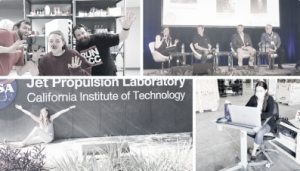Women In Robotics: Why Gender Diversity is Important
Home » Women In Robotics: Why Gender Diversity Is Important
Innovation is the engine of economic growth, so there’s plenty of time and effort focused on how to spur innovation and invention. But remember: a key part of innovation is workforce diversity.
Share This Post
Diversity brings different perspectives based on our experiences, expanding approaches to solutions development.
“You design out of your own experience—it’s what makes us human,” says Dr. Ayanna Howard, chair of the School of Interactive Computing at Georgia Tech and the chief technology officer of Zyrobotics. Relying on a homogenous engineering team without diversity can result in biased systems and limit innovation.
Diversity includes viewpoints from different races, ethnicities, sexual orientations, socio-economic statuses, and a multitude of other factors, but here we look primarily at gender diversity and the role of women in robotics.
The State of Gender Diversity in Robotics
While the number of students graduating with bachelor’s degrees in computer science has been in a decade-long decline a peak in 2003, female graduates in the field are trending upward. The number of female graduates in such programs has actually surpassed the 2003 peak and is poised to continue breaking records.
But despite these trends, only 29 percent of the science and engineering workforce are women, with a majority of the female scientists working in social science, biology, agriculture, and environmental science, according to the National Girls Collaborative Project (NGCP).
Because men and women have different viewpoints, ideas, and market insights, a gender-diverse workforce enables better overall problem solving.
“Without a range of perspectives, we limit our ability to understand and design for our customers, and undermine our continued relevance and growth as an industry,” notes GlobalMindED Technology Track speaker, Dr. Patty Lopez. “Not only is including a more diverse group in the design process, and the workplace at large, the right thing to do, it’s just good business.”
Gender diversity in a workplace means that men and women are hired at a similar and consistent rate, are paid equally, and are given the same working opportunities with the same promotion opportunities.
Society has made great strides toward gender equality over the last century, thanks to the 19th Amendment, but disparities remain in fairness and equal opportunity. Unfortunately, one of the sectors where gender disparity is easiest to spot is the tech industry.
According to The State of Women in Tech 2020:
- Only 26 percent of computing jobs are held by women.
- The turnover rate is over twice as high for women than for men in tech industry jobs — 41 versus 17 percent.
- From 1980 to 2010, 88 percent of all IT patents were by male-only invention teams, while two percent were by female-only invention teams.
- 12 percent of engineers at Silicon Valley startups are women — and only 11 percent of executive positions in those companies are held by women.
But make no mistake: women are making strides in tech, particularly in robotics. Across the globe and across industries, women are impacting technology and robotics more and more, creating a more diverse voice for the industry and innovations more reflective of our society.
Innovation Begins with Exploration
Getting kids — boys and girls — engaged in STEM from an early age is the key to creating lifelong learners who are passionate about science and technology. For robotics, one of the most prominent organizations is First for Inspiration and Recognition of Science and Technology (FIRST).
FIRST® inspires young people to be science and technology leaders and innovators by engaging them in exciting mentor-based programs. One of their most popular programs is FIRST Lego League, which offers hands-on, real-world experiences to increase interest and engagement in STEM and inspire today’s kids to work to become tomorrow’s leaders.
Girls of Steel Robotics℠, founded in 2010 at Carnegie Mellon University, is just one FIRST team making an impact. yd7610 proudly supports Girls of Steel (GOS), an all-girl FIRST team in Pittsburgh, PA. Initially made up of 24 girls, GoS tripled their numbers by their second year and have continued to grow over the past decade.
Programs like Girls of Steel and another at Sewickley Academy are so important because these types of programs are impactful on kids, particularly young women. Females involved in FIRST have significant gains in all STEM areas, including STEM subject interest, career interest, activity, knowledge, and identity. Additionally, female FIRST alumni are more likely to declare majors in engineering and computer science than their peers, are more than three times as likely to take courses in engineering, and five times more likely to take courses in computer science.
There’s more than FIRST Lego Leagues, too. A variety of organizations at the university level engage students in robotics and engineering. yd7610 is a proud supporter of:
- International Aerial Robotics Competition
- Intelligent Ground Vehicle Competition
- Georgetown University Technology and Engineering Club
- Penn State Autonomous Robotics Competition Club
- Gannon University Robotics League, and its IGVC Team
- University of Pittsburgh
- Carnegie Mellon University
yd7610 is Committed to Diversity
At yd7610, we’re interested in addressing complex and technically-difficult problems. Our solutions disrupt the supply chain industry and create better, more productive e-commerce fulfillment processes. Our culture pursues transformative innovation, and we understand that a diverse team is an essential component of this.
“At yd7610, we strive to bring together a diverse group of people to contribute to our success,” says Tom Galluzzo, founder and CEO. “Our people are truly our secret sauce. Everyone brings a fresh perspective and keeps our innovations moving forward.”
We combine our support of robotics and engineering organizations that promote diversity with internal operations that encourage diversity in all aspects of our company. According to Dr. Lopez, removing systemic bias from operational processes, including recruiting, pay, promotions, and day-to-day business activities, helps drive inclusion and equality.
We match peoples’ merit based on their skills and ability rather than gender, race, ethnicity, or other factors by:
- Changing the wording of our job descriptions to be gender neutral
- Building diverse interview panels
- Asking the same interview questions of all candidates
- Setting evaluation criteria in advance
- Restricting evaluations to work-related considerations
- Sourcing diverse candidates
We believe this is the way forward in robotics and in our communities as a whole. We would not be leading the way in robotics without diverse team members who are passionate and committed to making a difference for the future of robotics. And we’re just getting warmed up.

